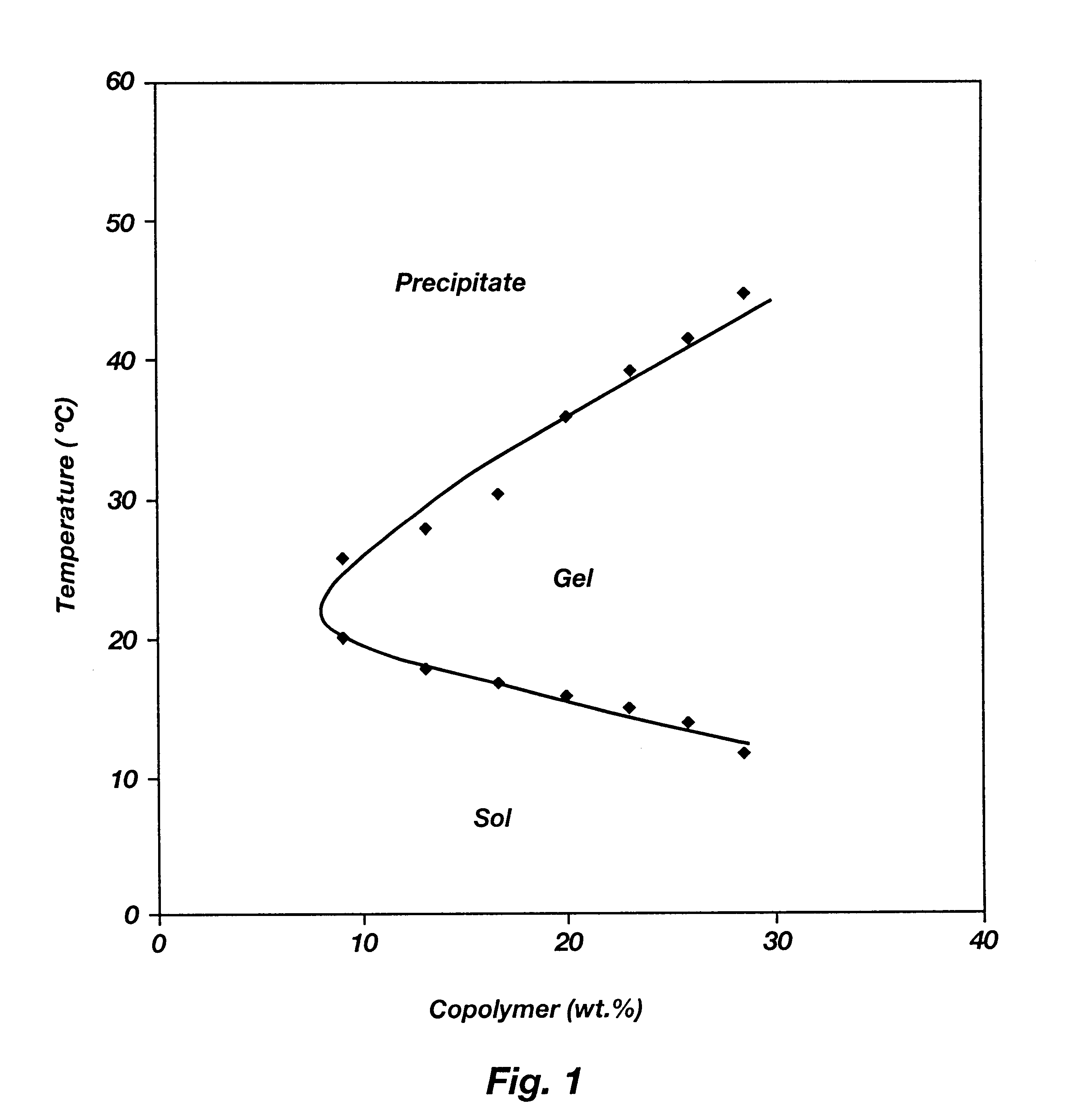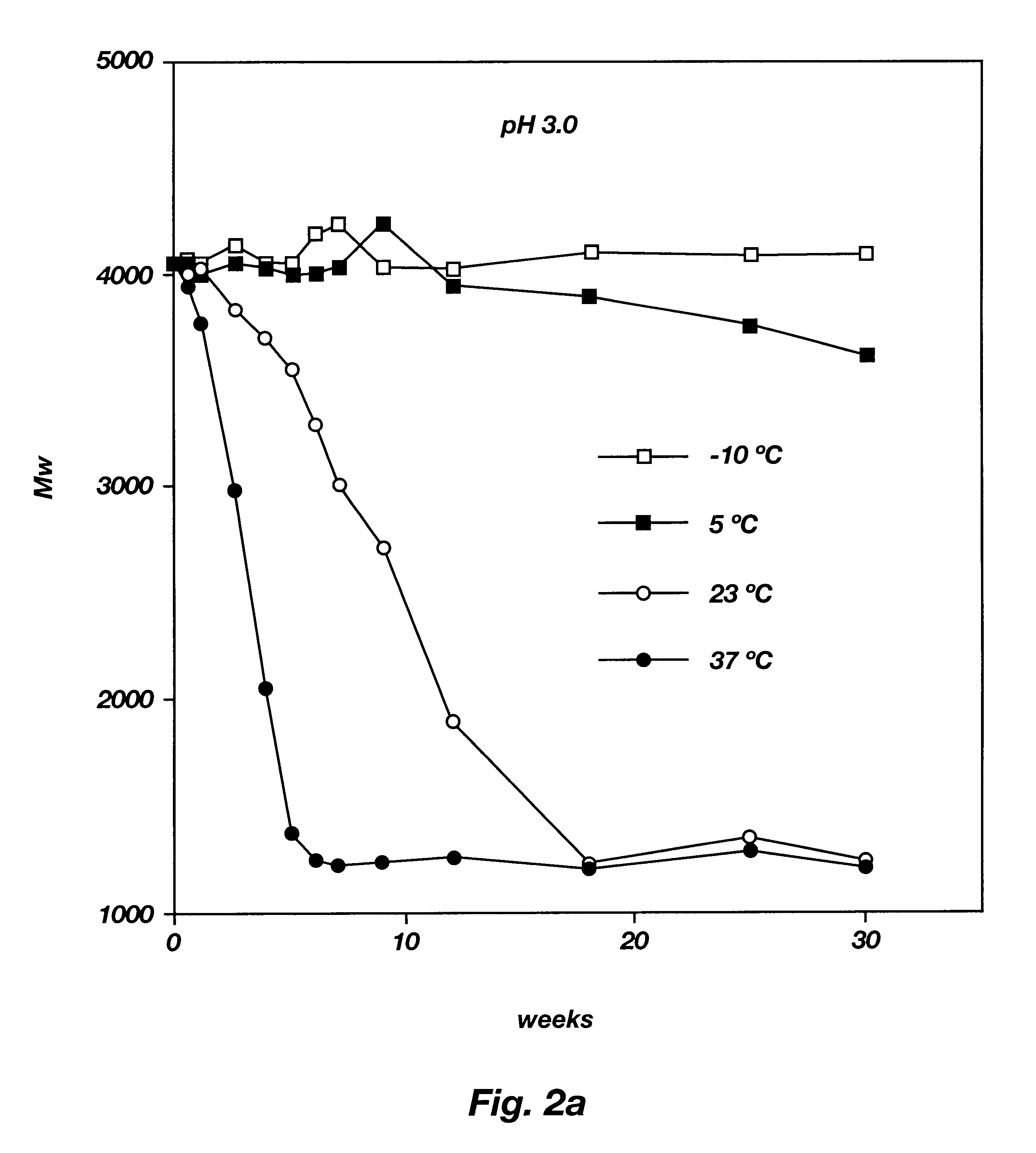Biodegradable low molecular weight triblock poly(lactide-co- glycolide) polyethylene glycol copolymers having reverse thermal gelation properties
a low molecular weight, polyethylene glycol technology, applied in the direction of depsipeptides, peptide/protein ingredients, powder delivery, etc., can solve the problems of high molecular weight of polypeptides or proteins, limited solubility and/or stability, and short half-life in the body limited to parenteral administration, etc., to achieve the effect of reducing the number of side effects
- Summary
- Abstract
- Description
- Claims
- Application Information
AI Technical Summary
Benefits of technology
Problems solved by technology
Method used
Image
Examples
example 1
Synthesis of PLGA-PEG-PLGA Triblock Copolymer by Ring Opening Copolymerization
Following the reaction scheme given above, PEG (Mw=1000) was dried by azeotropic distillation in a flask with toluene (2.times.75 ml) under an atmosphere of nitrogen followed by drying at 130.degree. C. under vacuum (5 mm Hg). Lactide and glycolide monomers (in mole ratios of 3:1, respectively) were added to the flask followed by the addition of stannous octoate (0.1 wt %) and the reaction mixture was heated at 150.degree. C. under vacuum (5 mm Hg). The progress of the reaction was followed by GPC (gel permeation chromatography). After an appropriate time, the reaction was stopped and the flask was cooled to room temperature. The residue was dissolved in cold water and heated to 70-80.degree. C. to precipitate the polymer formed. The supernatant was decanted and the polymer residue was again dissolved in cold water and heated to induce precipitation. This process of dissolution followed by precipitation wa...
example 2
Following the basic procedure outlined in Example 1, other triblock copolymers using the same PEG (Mw=1000) but varying the lactide and / or glycolide content. The properties of these triblock copolymers are listed in the following table:
It is to be noted that all of the polymers listed in the above table possessed reverse thermal galation properties even when the lactide (LA) content varied from 30 to 100 mole % and the glycolide (GA) content varied from 0 to 70 mole %. Hence, both PLGA-PLA-PEG-PLA triblocks are shown in this example.
example 3
Synthesis of PLGA-PEG-PLGA Triblock Copolymer by Condensation Copolymerization
Into a three necked flask, equipped with a nitrogen inlet, thermometer, and distillation head for removal of water, was placed DL-lactic acid and glycolic acid (3:1 mole ratio, respectively). The reaction mixture was heated at 160.degree. C. under nitrogen, with stirring, at atmospheric pressure for three hours and then under reduced pressure (5 mm Hg). The progress of the reaction was followed by GPC. The reaction was stopped at the appropriate time and the polymer formed was purified by precipitation from a dichloromethane solution into a large excess of methanol. The residue was triturated with methanol and dried under vacuum (0.05 mm Hg) at 23.degree. C. The PLGA oligomer was characterized by GPC, IR and NMR. The resulting PLGA oligomer had a weight average molecular weight (Mw) of 9900, a number average molecular weight (Mn) of 5500 and an Mw / Mn ratio of 1.8.
The PLGA was mixed with PEG (Mw=1000) and w...
PUM
| Property | Measurement | Unit |
|---|---|---|
| Percent by mass | aaaaa | aaaaa |
| Percent by mass | aaaaa | aaaaa |
| Percent by mass | aaaaa | aaaaa |
Abstract
Description
Claims
Application Information
 Login to View More
Login to View More - R&D
- Intellectual Property
- Life Sciences
- Materials
- Tech Scout
- Unparalleled Data Quality
- Higher Quality Content
- 60% Fewer Hallucinations
Browse by: Latest US Patents, China's latest patents, Technical Efficacy Thesaurus, Application Domain, Technology Topic, Popular Technical Reports.
© 2025 PatSnap. All rights reserved.Legal|Privacy policy|Modern Slavery Act Transparency Statement|Sitemap|About US| Contact US: help@patsnap.com



